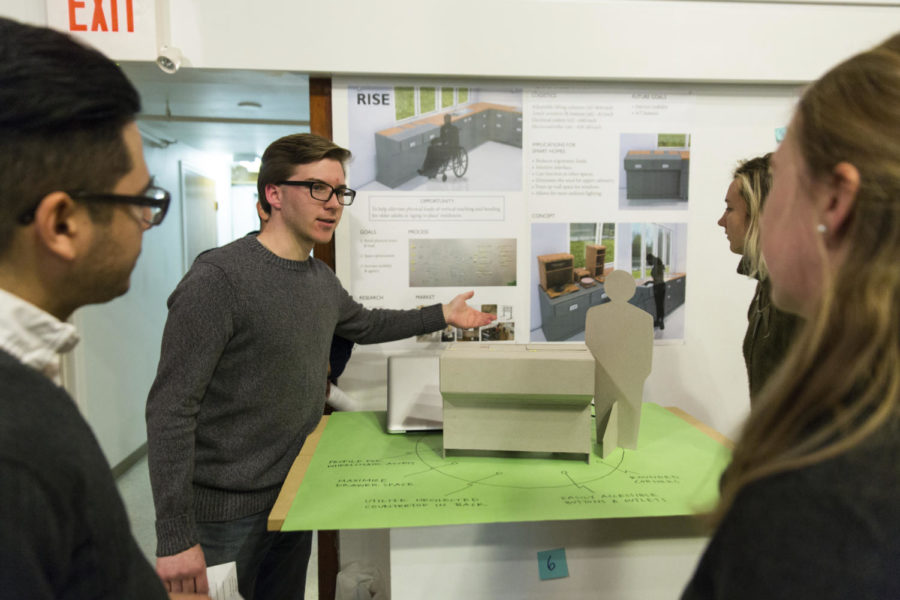Iowa State students ‘RISE’ to the occasion in aging innovation competition
RISE, the winning team of the ISU Innovation in Aging Charrette, present at the charrette in January.
March 10, 2019
Innovations by a team of Iowa State students won the recent Iowa State University Innovations in Aging Charrette.
The group consisted of Samantha Creeger, graduate student in industrial design; Jonathan Kirner, senior in industrial design; Mehdi Saraeian, graduate student in mechanical engineering, and John Osorio, graduate in industrial design.
The team got together after Creeger saw the ad for the event, and the group ended up being one of nine teams competing. Each team had between three and five people within a variety of majors.
Hannah Dannewitz, graduate student in human development and family studies and one of the coordinators of the event, said the idea behind the event was to create innovations that allow aging adults to stay in their own homes. The innovations will adapt and change as adults age.
A group of professors, including Jennifer Margrett, associate professor of human development and family studies, were brought together to help WesleyLife come up with the top innovations that help aging adults.
WesleyLife is a company that runs retirement communities all over Iowa. The company recently bought 13 plots of land within a residential neighborhood in Johnston, Iowa, and are going to build 13 smart homes. Dannewitz said these homes will allow older adults to live independently.
After Margrett saw a charrette at another university, she knew they needed to bring it to Iowa State. Margrett called in Dannewitz and Lauren Stratton, graduate student in human development and family studies, to coordinate the event.
“[A charrette is] a contest where stakeholders, people who have a stake in a certain kind of activity, get together and it’s usually very interdisciplinary, so people from all different areas so we can form teams where people have different skill sets, and then they work together to solve a problem,” Dannewitz said.
When the teams showed up for the event in late January, they were given a history of the company and the ideas of what the company was looking for. The teams were then given categories to help brainstorm ideas.
“We didn’t have any ideas, our goal for the first day was just to think of as many ideas and concepts as possible,” Creeger said. “We wanted to come in with a clear mind and hear what the professors and professionals in the field had to say.”
Creeger’s team said they took the categories they were given and each chose two or three that stood out to them to start writing their ideas on sticky notes. After a few minutes, the team looked at them all and looked for overlap leading them into a particular direction.
The team eventually narrowed their ideas down to two major directions and used advice from the professionals to see what direction they wanted to go. The first idea dealt with medication adherence while others dealt with vertical challenges.
“One was to try and deal with physical loads in reaching for items up high or bending for items down low, so we kinda considered that as a vertical challenge kind of topic,” Osorio said.
By Saturday afternoon they had their idea set and began to sketch out ideas. Creeger even called her grandparents to see what would be most practical.
This is where the team came up with “RISE.” The idea of RISE is a smart storage system, initially in a kitchen setting, that consists of concealed cabinetry that surfaces with the push of a button. This allows adjustable heights for older adults to not worry about overreaching for items.
To present their idea, the team made both a poster and a miniature model of the cabinets. Creeger also started their presentation with a story of her grandmother to make it more personal.
“We had three main purposes, one was to show how the system works, how does it help people reach more cabinet space essentially, and then how does it help optimize the room better like having more windows, more light, and one more thing was to make it personalized,” Saraeian said.
The team said overall they had fun doing the project and they got along together well. They said they were able to use all of their backgrounds together, and the event was very humbling to put themselves in older adults position.
“The overall goal of the competition was to create something that is adaptable for older adults and we really wanted to focus on something that was simple and intuitive that older adults can transition throughout their life,” Creeger said.
As for what will happen next with the project the team says it’s still up in the air. They have intentions of continuing with project “RISE,” but need some more time and help from outside sources to make it happen.







